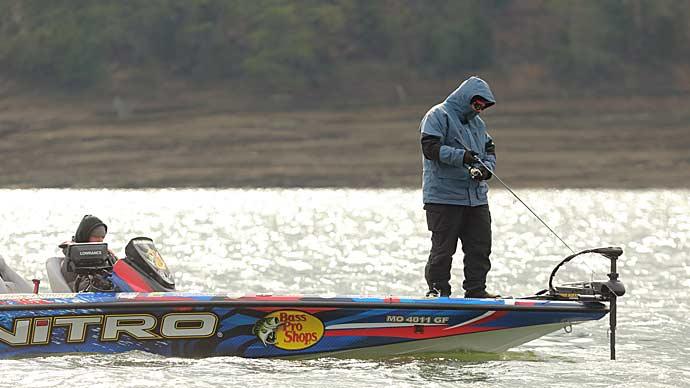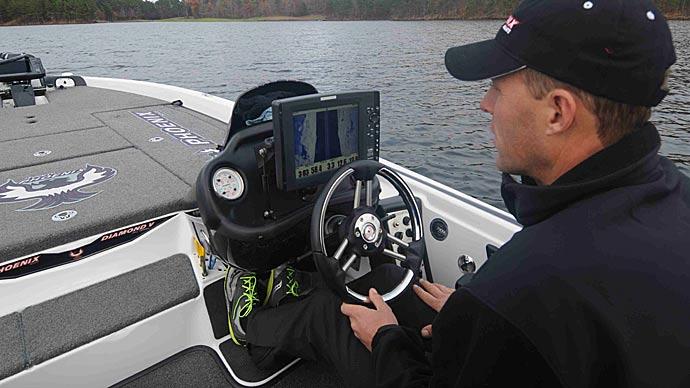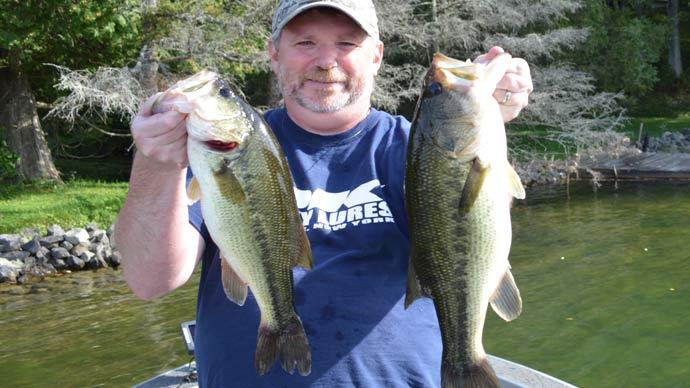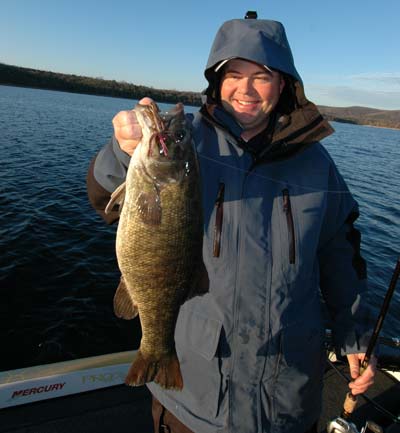
Following their food or their urges to reproduce cause bass to live in a constant state of transition.
These nomadic fish follow traditional migration routes, moving from deep-water haunts to the shallows. The routes in most reservoirs are usually creek and river channels that allow bass to move from deep structure where the fish reside in the summer and winter to shallow flats where bass spawn in the springtime and feast on baitfish in the fall.
Transition banks serve as holding areas along the migration routes, so the key to finding bass as they make their seasonal treks is to locate bank changes. Looking at a topographic map will help you find some transition banks before you head out onto the lake. Former Bassmaster Elite Series pro Brian Snowden looks for banks where the map’s contour lines bend towards the shoreline indicating a channel swing.
Missouri tournament angler Scott Pauley also looks for spots on the map where the depth lines tighten. “But I’ve got to look at the rock or the bank itself before I can tell for sure if it is a good transition spot,” he says. “A transition bank is where you really have to key on the change in the rocks. I look at the angle of the bank and the type of rocks as keys to finding bass. So a transition is where the bank changes from bluff rock to chunk rock to pea gravel.”
Reservoirs throughout the country feature about the same transition banks but have a few subtle differences. On the White River chain of lakes (Beaver, Bull Shoals, and Table Rock) in the Ozarks highlands, Snowden fishes three types of transition banks:
- Bluff ends changing to rock the size of cantaloupes or watermelons
- Chunk rock changing to pea gravel
- Gravel changing to mud or clay
The Missouri angler keys on the bluff/bigger rock bank change in the winter and early spring, where he uses a suspending stickbait or 5/16- to 7/16-ounce jig. He also fishes these banks in the summer with a Texas-rigged plastic worm or a Carolina rig. His favorite fall transition banks are the flats that change from mud to gravel, where he likes to throw a lipless crankbait or a spinnerbait.
These lakes contain multiple species of bass that seem to favor certain transition banks. Snowden notices spotted bass prefer the bluff/gravel change, while largemouth and smallmouth hold more on the chunk/rock pea gravel transition spot, and largemouth also like the clay/gravel flats.
Snowden focuses on seasonal patterns to determine the bass depth along bank changes. "I've caught some fish, though, on Beaver Lake along transition banks in the winter in 2 to 5 feet of water," he says. In the spring, he notices bass suspend more along the transition banks at depths of 5 to 15 feet. Snowden's most productive depth range in the fall along the mud/gravel flats is 1 to 5 feet deep.
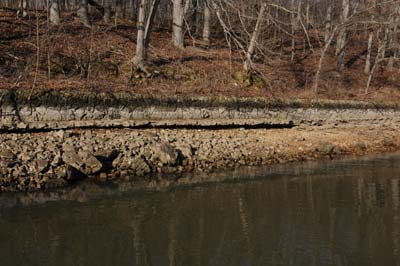
A subtle change in the transition bank is a sweet spot for Snowden in his home waters. "The ideal situation is if you can find one that has a little channel coming up close to it where the bank has a little indentation and is a little deeper than the rest of the transition area," he says. "That really seems to hold the fish better."
While honing his skills fishing regional tournaments at Lake of the Ozarks and Truman Lake in Missouri, Pauley discovered bass in these impoundments use the creek channels to move from steep banks to the flat gravel shores throughout the year.
Spots, where the channel swings close to a point and the shoreline changes from bluffs to chunk rocks, are prime examples of transition banks on these lakes. Another key transition spot is chunk rocks changing to pea gravel.
Sweet spots can usually be found along these bank changes. Pauley looks for any swing or indentation along the bank, whether a bluff, chunk rock, or pea gravel bank. “If all of a sudden there is a little indentation—maybe the size of a table—that spot will seem to hold one or two fish more than any other along the bank," he says.
Isolated cover also becomes a sweet spot along bank changes. On a timber-laden reservoir such as Truman, standing timber and lay-downs serve as potential sweet spots, while boat docks on lakes with residential developments are the best shelters for bass along transition banks.
Pauley also focuses on seasonal patterns to determine how to fish transition banks throughout the year. In the winter, Pauley keys on steeper banks where he works a suspending stickbait or a jig-and-craw combination. He targets chunk rock banks and throws a Storm Lures Wiggle Wart crankbait or a jig when the water warms in the early spring. Throughout springtime and early summer, Pauley follows bass to pea gravel banks and catches spawning and post-spawn fish on jigs, tube baits, topwater lures, and soft plastic jerkbaits. Bass migrate to the drop-offs by summertime, where Pauley catches them on plastic worms and jigs.
During the fall, Pauley keys on isolated wood cover along transition banks in the major creeks. He favors burning a 1/2-ounce Rat-L-Trap around stickups and root wads, a technique Pauley employed to take the lead on the first day of the 1999 Missouri Bassmaster Invitational at Lake of the Ozarks.
If you have trouble finding bass, look for a bank change to cash in on catching these aquatic nomads.


